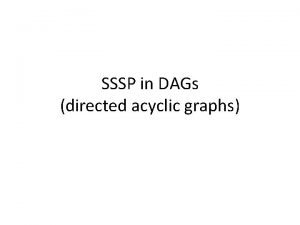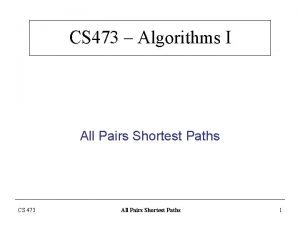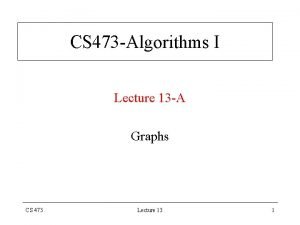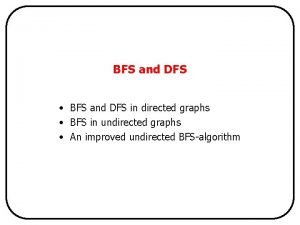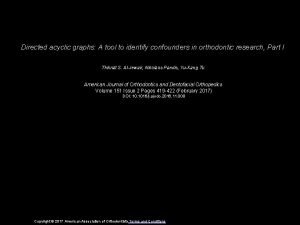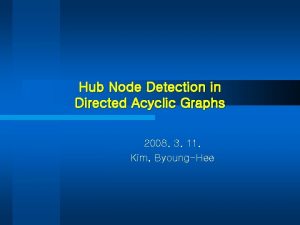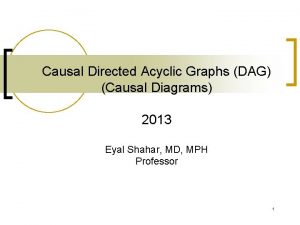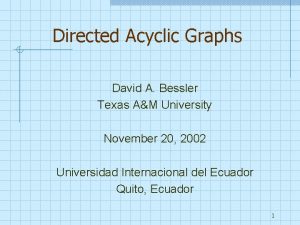SSSP in DAGs directed acyclic graphs DFS depth











- Slides: 11

SSSP in DAGs (directed acyclic graphs)

• DFS (depth first search) DFS(vertex v) { v. visited = TRUE; for each w adjacent to v do if(!w. visited) then dfs(w); } • If G=(V, E) not (strongly) connected then it may have DFS forest

Topological Sort: Ordering of vertices in a DAG based on precedence : if path then vi before vj in ordering – not unique: – V V : indegree(v): #edges(u, v) E – Can use DFS to obtain TS order – Given directed graph G, is it a DAG? • Can use TS to answer it ( cannot find vertex with indegree 0)

TS algorithm • Output (number) v V with indegree 0 • (remove v and its outgoing edges) • Repeat until no vertex left

TS algorithm • How to find v V with indgree(v)=0 – Use queue: • Each time incoming edge at u V is removed, decrease indegree(u) • If indegree(u) is 0, place u in queue • O(|V|+|E|) time – Init: • Find v V with indegree(v)=0 in O(|V|) time • Place in queue

DAG and TS • Lemma 1: A DAG has a sink(outdegree=0) and a source(indegree=0) – Proof: • Let P be the longest path in G, • Claim: u is a source – If not, (w, u). If w∉P => P’ = {(w, u)} U P is longer than P. If w p => cycle: • A similar argument shows v is a sink

Theorem 1: A directed G has a TS G is a DAG • Proof: – Assume G has TS and a cycle C. Let Vi C be the vertex with smallest index assigned by TS. There is then an edge (Vj, Vi), with Vj C and j>I => contradiction with TS assignment. Now Assume G acyclic. Use induction: – Define P(n): a DAG with n vertices has a TS – P(1) = true Assume P(m) is true, Let G have m+1 vertices => source V 0. G{V 0} has TS V 1 , V 2 , …, Vm => G has TS V 0 , V 1 , …, Vm

SSSP in DAG (cont. ) • Use vertex selection rule: select in TS order – SP well defined, even if negative weight edges ( negative weight cycle cannot exist) DAG-SP(G, w, s) Topologically sort vertices of G Init-Single-Source ( G, s) For each u ∈V, in TS order do For each v ∈Adj[u] do Relax(u, v, w) – O(|V|+|E|) time

SSSP in DAG (cont. ) • Critical path in a DAG: longest path through the DAG – Can find one by: • (1) negating edge weights and running DAG-SP, or • (2) run DAG-SP with modifications: – Replace “∞” by “- ∞” in init-single-source – Replace “>” by “<“ in RELAX – Note: Longest simple path in unweighted graph is NP-Complete

BFS( breadth first search) • Visit all nodes at same level before going to next level; use queue for this • Queue_init(); id=0; visited[u]=0, u V; Bfs(v V){ enqueue(v); While(!queue_empty()){ u=dequeue(); visited[u]=++id; (need 3 values) for each w adj[u] do if(visited[w]==0){enqueue(w); visited[w]=-1} } } How many levels in the queue at a time?

Application: Unweighted SPs • δ(s, v) : #edges on the path (all edges have weight 1) • Use BFS: need min # edges to reach u V from s. – Process vertices by layers: • Process those that can be reached with 1 edge • Process those that can be reached with 2 edge, etc. – Use a queue: • Check d[v]: if d[v]= ∞ , place in queue.

